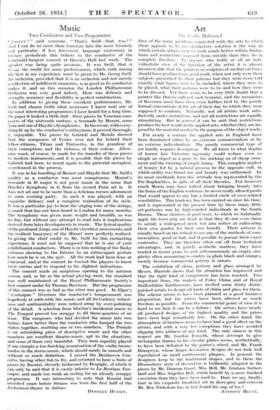Art
The Crafts Delivered ONE of the many- probk•ins connected with the arts to which there appears to be no satisfactory solution is the way in which certain artists seem to work much better within limita-
tions and restrictions imposed from outside than they do in complete freedom. To anyone who holds at all an indi- vidualistic view of the function of the artist it is almost inconceivable that the painters or sculptors of mediaeval times Should have produced any good work, when not only were their subjects prescribed by their patrons but they were even told
exactly what figures were to be included, where they were to be placed, what their gestures were to be and how they were to be dressed. Yet there seems to be very little doubt that a
painter like Duceio suffered such tyranny, and the mosaicists of Ravenna must have been even further tied by the purely formal conventions of the art of their day to which they were supposed to conform. Naturally, not all artists work satis- factorily- under restrictions, and not all restrictions are equally stimulating. But in general it can be said that restrictions produce the best results in the applied arts, whether they are im- posed by the material used or by the purpose of the object made.
For nearly a century the applied arts in England have been dominated either by an extreme commercialism or by an extreme individualism. The purely commercial type of art hardly requires description. We all know to what depths of horror late Victorian ingenuity could . reduce even so simple an object as a grate by the sticking on of cheap orna- ment and the twisting of simple forms. This complete neglect of beauty led by a natural process to the opposite cult, in which utility was thrust out and beauty was enthroned. In its most creditable form this attitude was represented by the Pre-Raphaelites, in spite of all their theories. For however much Morris may have talked about bringing beauty into the home of the English workman, he never really offered goods that would appeal to any but a limited circle of over-refined sensibilities. This tendency has been carried on since his time, and is represented at the present time by those many little art-potteries run by high-minded individuals in the South Downs. These cloisters of good taste, to which we habitually apply the term arty, are dead. in that they do not even claim to satisfy a widespread need, but aim rather at cultivating their own garden for their own benefit. Their artiness is usually based on the refusal to use any of the methods of com- mercialism, good or bad, and if possible to pursue their exact contraries. They are therefore often cut off from technical advantages, and, in purely aesthetic matters, they have tended in recent years to seek self-consciously an empty sim- plicity often amounting to crudity (a plain black and orange), merely because commercial pottery is ornate.
The exhibition of china, pottery and glass arranged by Messrs. Harrods shows that the situation has improved and that the right kind of compromise has been reached. Two important firms, the makers of Foley China and of Royal Staffordshire Earthenware, have invited some thirty distin- guished artists to design all kinds of china and glass for them. The scheme seems to have been planned as a good business proposition, but the artists have been allowed as much freedom as possible. From the commercial. point of view it is hard to see how it can be a failure.; the artists have nearly all produced designs of the highest quality and the prices have been kept remarkably low. On the other hand, the atmosphere of business seems to have had a good effect on the artists, and with a very few exceptions they have avoided slipping into artiness of any kind. The only sinners in this respect are Mr. Gordon Forsyth, whose attempt to give rectangular frames to his circular plates seems, aesthetically, to have been defeated by the potter's wheel, and Mr. Frank Brangwyn, whose larger decorative designs do not look well reproduced on small earthenware plaques. In general, the designers keep to the traditional shapes, and to them the Bloomsbury style of decoration is brilliantly adapted in the pieces by Mr. Duncan Grant, Mrs. Bell, Mr. Graham Suther- land and Miss Angelica Bell, which benefit by a more finished execution than they have been used to. Dare we say, finally, that in his exquisite breakfast set in dove-grey and crimson Mr. Ben Nicholson has at last found his cup of tea ?
ANTHONY BLUNT.






















































 Previous page
Previous page